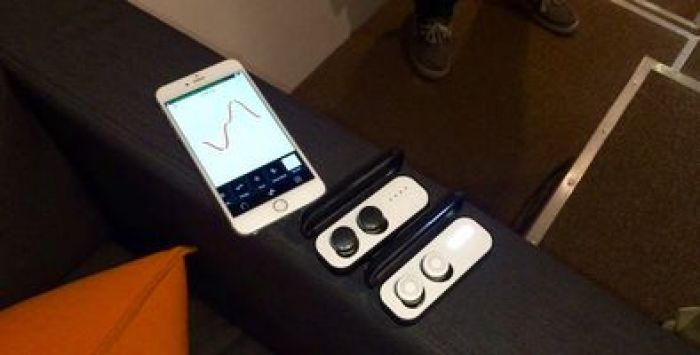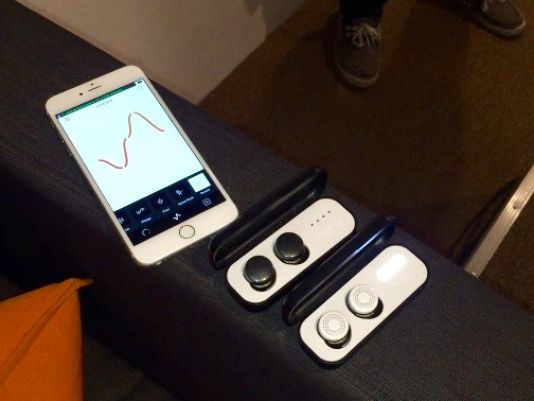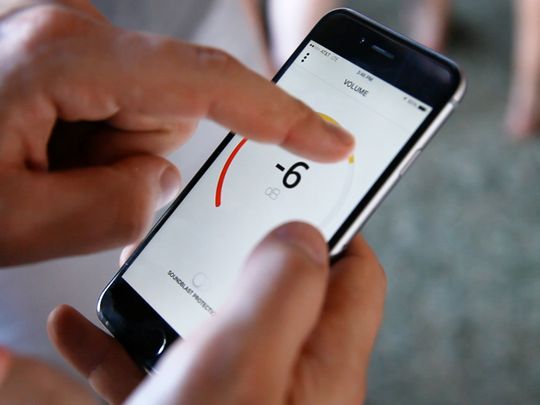Here listening tech 'like having superhuman hearing’

The Here Active Listening System are similar to earbuds, but do so much more. Columnist Jennifer Jolly explains how they work.

The Here Active Listening System.(Photo: Doppler Labs)
Life is getting louder. Noise pollution is up[1] in just about every major city in America, where the unrelenting thrum of traffic, jets, construction, sirens, horns, music, and everyday chatter now pushes volume levels to a not-so-dull roar at all hours of the day and night. Even in rural areas, quiet is harder to come by[2], especially with our always-on smartphones and always-in earbuds.
Noise is kind of like second-hand smoke, “so pervasive we just put up with it,” Doppler Labs[3] Co-founder and CEO Noah Kraft said as he handed me a pair of small, button-like earbuds. “You should have a choice in what you hear and how you listen to the world.”
Kraft and a team of audio engineers, product designers, and top tech talent[4] from the ranks of Apple, Google, and Microsoft created a new wearable device called the Here Active Listening System[5]. It’s a $199 pair of wireless, penny-sized hi-fi audio computers that sit just outside your ear to let you control volume and add audio equalization to the soundtrack of your real life.
With Here’s mobile companion app, you can turn up a particular person’s voice while turning down background chatter. Or you can remix live music right in your ears. You can even selectively mute specific sounds — like that crying baby sitting two rows back on an airplane or the kid sitting next to you smacking his gum—while still hearing everything else around you.
“It’s like having superhuman hearing,” Kraft explained as he sat down next to me in a small glassed-off corner of Doppler Lab’s new cement, mostly-underground office in San Francisco’s South of Market district. “We want to make hearing less passive and more awesome.”
As he talked, Kraft spun a touch screen dial on the Here smartphone app, “This is your volume knob on the world,” he said as he dialed it up five decibels. He suddenly sounded like the voice of God booming inside my head. (I’m pretty sure I could hear him in my back teeth.) As he took the dial the other direction, his voice fell to a muted library whisper.
The app also has a list of effects to adjust the equalizer, or “EQ,” settings to balance the bass, midrange or treble. You can even get really fancy and play around with reverb, flange, delay, noise mask, echo and more. It’s an audio buff’s dream come true.
Echo put me in the Grand Canyon, where every word repeated, then slowly faded away. When Kraft hit reverb, he instantly sounded like an announcer at a baseball game. Flange made me feel like I was hallucinating, like my ears were on an acid trip.

The Here app features a variety of effects and filters to control your auditory environment. (Photo: Doppler Labs)
I’m impressed. Experiencing the “Here-buds” first-hand reminded me of Oculus Rift, the virtual reality headset, but for your ears. It’s like augmented “hear-ality.”
While this highly personalized “bionic hearing” is what excited me the most — the idea of tuning out everything except the person sitting across from me in a loud restaurant, and muting a person next to me who is chewing and slurping while they eat with their mouth open—music, not utility, inspired Kraft’s vision of Here.
Kraft said he’s been thinking about sound for most of his life. He’s played the drums since he was five and grew up in Los Angeles watching his father,[6] a longtime president of Fox Music, manage the musical scores for more than 300 feature films. But it wasn’t until he toured with an electronic musician a few years ago that it all came together, he says, when he noticed how much the same music varied venue to venue and even from spot to spot in a room. “You pay the same amount,” he said, “but you go stand in the back left — it’s totally different audio. What if there were a way to skip the sound guy, and optimize your own ears?”
To prove his point, Kraft played the clubby dance track Sintra[7] by Flume. He ramped up the already deep thumping bass to the point I felt my chair swaying and wondered for a second if we were having an earthquake. He switched over to a high-tempo hip-hop cacophony by rapper Dizzee Rascal[8]. This music made me wish I could crawl out of my own skin. Kraft then transitioned seamlessly over to the beautiful piano solo Gymnopedie[9] and I was instantly transformed to Carnegie Hall, where I imagined that I was listening to a live performance.
For now, Doppler Labs main focus is on music and marketing to a small, but deeply passionate community that wants to remix live performances, “Here 1.0 is an episodic, niche product for people who dream of adjusting the sound of a live concert until it’s just right,” Kraft explained. The success of Here’s Kickstarter campaign[10] which blew past its $250k goal last summer to raise more than $630,000, suggests that Kraft and Doppler Labs may be underestimating its appeal just a tad. The company also wrapped up a $17 million funding round and has the music industry buzzing with early investors such as Hans Zimmer and Quincy Jones.
Doppler’s grand plan though, extends far beyond music, and this is the part I care about the most, “to have a computer, speaker and microphone in every ear,” which is an obvious riff off of Microsoft’s old adage of having a computer on every desk. Just as that prediction came true, there’s a good chance Here’s will too.
Our ears are primed to become the go-to platform for a wearable renaissance, since a huge chunk of the population already wears headphones or earbuds a good deal of the time anyway. Imagine a gadget like Here being able to translate another language in real time. Or to connect with Bluetooth and GPS, so it can tell when you’re sleeping and mute out your spouse’s snoring, but make sure you hear if the dog barks or baby wakes up. When you’re out hiking, it could mute out traffic or jets, but make sure you hear if a bicycle (or bear) approaches. Kraft predicts that in 10 years people will wear some iteration of Here bud 24 hours a day. (I won’t, unless they come more in the shape of earrings…which Kraft told me they’ll consider.)
“We aim to use tech to enhance life,” he says. That’s a lofty goal, but one this company might actually pull off. I’m anxious to get a pair for myself, not for live music, but to cut the noise and enhance the sweeter sounds of my life. That plus muting the whole other people chewing thing is well worth the $200 to me.
Jennifer Jolly is an Emmy Award-winning consumer tech contributor and host of USA TODAY's digital video show TECH NOW. E-mail her at techcomments@usatoday.com[11]. Follow her on Twitter @JenniferJolly[12].
Read or Share this story: http://usat.ly/1MM02al
References
- ^ Noise pollution is up (darwin.bio.uci.edu)
- ^ quiet is harder to come by (news.sciencemag.org)
- ^ Doppler Labs (www.dopplerlabs.com)
- ^ top tech talent (www.dopplerlabs.com)
- ^ Here Active Listening System (www.hereplus.me)
- ^ father, (www.kraftbox.com)
- ^ Sintra (soundcloud.com)
- ^ Dizzee Rascal (www.dizzeerascal.co.uk)
- ^ Gymnopedie (itunes.apple.com)
- ^ Here’s Kickstarter campaign (www.kickstarter.com)
- ^ techcomments@usatoday.com (rssfeeds.usatoday.com)
- ^ @JenniferJolly (twitter.com)









